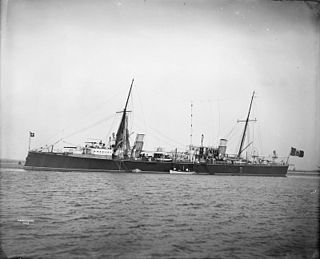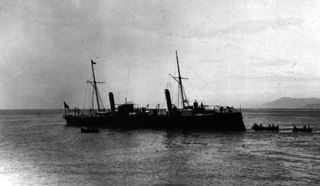 W
WThe Partenope class was a group of eight torpedo cruisers built for the Italian Regia Marina in the 1880s and 1890s. The class comprised Partenope, Minerva, Euridice, Urania, Iride, Aretusa, Caprera, and Calatafimi. Based on the earlier cruiser Tripoli, the Partenope class represented a temporary embrace of the Jeune École, which emphasized the use of cheap torpedo-armed vessels as a means to defeat the much more expensive ironclad battleships of the day. To fulfill their intended role, the vessels were armed with five or six 450 mm (17.7 in) torpedo tubes.
 W
WAretusa was a torpedo cruiser of the Partenope class built for the Italian Regia Marina in the 1880s. Laid down in June 1889 at the Cantiere navale fratelli Orlando shipyard, she was launched in March 1891 and was commissioned in September 1892. Her main armament were her six torpedo tubes, which were supported by a battery of ten small-caliber guns. Aretusa spent most of her career in the main Italian fleet, where she was primarily occupied with training exercises. At the start of the Italo-Turkish War in September 1911, she was assigned to the Red Sea Squadron in Italian Eritrea. She bombarded Ottoman positions in the Arabian Peninsula and took part in a blockade of the coast. Worn out by the end of the war in October 1912, Aretusa was sold for scrap that December and broken up.
 W
WCalatafimi was a torpedo cruiser of the Partenope class built for the Italian Regia Marina in the 1880s. She was built by the Cantiere navale fratelli Orlando shipyard; her keel was laid in July 1891, she was launched in May 1894, and was commissioned in December 1895. Her main armament were her five torpedo tubes, which were supported by a battery of eleven small-caliber guns. Calatafimi spent most of her career in the main Italian fleet, where she was primarily occupied with training exercises. The ship was sold in March 1907 and broken up for scrap.
 W
WCaprera was a torpedo cruiser of the Partenope class built for the Italian Regia Marina in the 1880s. She was built by the Cantiere navale fratelli Orlando shipyard; her keel was laid in July 1891, she was launched in May 1894, and was commissioned in December 1895. Her main armament were her five torpedo tubes, which were supported by a battery of eleven small-caliber guns. Caprera spent most of her career in the main Italian fleet, where she was primarily occupied with training exercises. She served in the Red Sea during the Italo-Turkish War of 1911–12, where she conducted shore bombardments and blockaded Ottoman ports in the area. Caprera did not remain in service long after the war, being sold for scrap in May 1913.
 W
WEuridice was a torpedo cruiser of the Partenope class built for the Italian Regia Marina in the 1880s. She was built by the Regio Cantiere di Castellammare di Stabia shipyard, with her keel laying in February 1889, her launching in September 1890, and her commissioning in May 1891. Her main armament were her six torpedo tubes, which were supported by a battery of ten small-caliber guns. Euridice spent most of her career in the main Italian fleet, where she was primarily occupied with training exercises. She was withdrawn from service in 1907 and sold for scrapping.
 W
WIride was a torpedo cruiser of the Partenope class built for the Italian Regia Marina in the 1880s. Laid down in February 1889 at the Regio Cantiere di Castellammare di Stabia shipyard, she was launched in July 1890 and was commissioned in November 1892. Her main armament were her six torpedo tubes, which were supported by a battery of ten small-caliber guns. Iride spent most of her career in the main Italian fleet, where she was primarily occupied with training exercises. During the Italo-Turkish War in September 1911, she remained in Italian waters until late in the conflict; she escorted a troop convoy to North Africa in April 1912 and bombarded Ottoman positions in June and July. Iride was eventually broken up for scrap in December 1920.
 W
WMinerva was a torpedo cruiser of the Partenope class built for the Italian Regia Marina in the 1880s. The second of eight ships, Minerva was built by Gio. Ansaldo & C.; her keel was laid down in February 1889, she was launched in February 1892, and she was commissioned in August that year. Her main armament were her five torpedo tubes, which were supported by a battery of ten small-caliber guns. Minerva spent most of her career in the main Italian fleet, where she was primarily occupied with training exercises. She was converted into a minelayer in 1909–10. She did not see significant action during the Italo-Turkish War in 1911 or World War I in 1915–18, though she was used to lay defensive minefields during the latter conflict. The ship was sold for scrap in 1921.
 W
WPartenope was a torpedo cruiser built for the Italian Regia Marina in the 1880s, the lead ship of her class, which included seven other vessels. The ship was built by the Regio Cantiere di Castellammare di Stabia; she was laid down in June 1888, was launched in December 1889, and was completed in September 1890. Her main armament were her five torpedo tubes, which were supported by a battery of ten small-caliber guns.
 W
WUrania was a torpedo cruiser of the Partenope class built for the Italian Regia Marina in the 1880s. She was built by the Cantieri navali Odero shipyard; her keel was laid in February 1889, she was launched in June 1891, and was commissioned in July 1893. Her main armament were her six torpedo tubes, which were supported by a battery of ten small-caliber guns. Urania spent most of her career in the main Italian fleet, where she was primarily occupied with training exercises. She was still in service at the outbreak of the Italo-Turkish War in September 1911, but she did not take part in any operations. Instead, she remained in Italian waters and was broken up for scrap in January 1912.